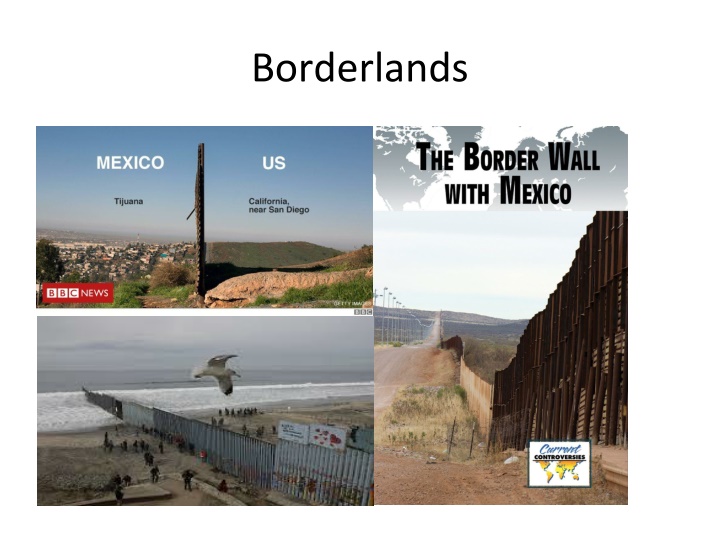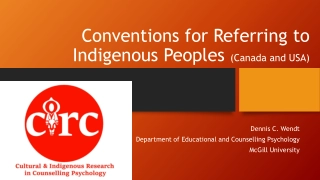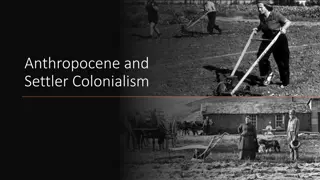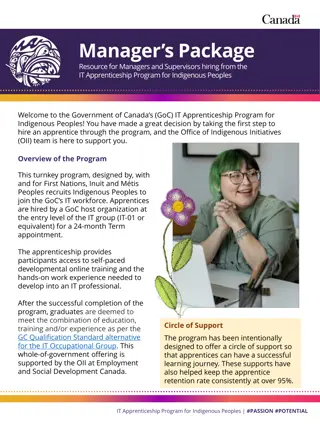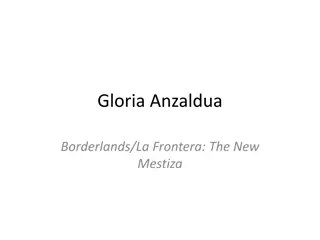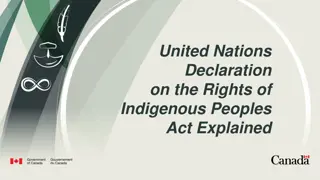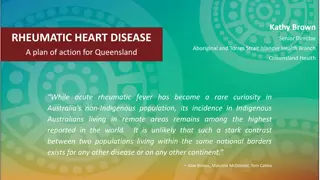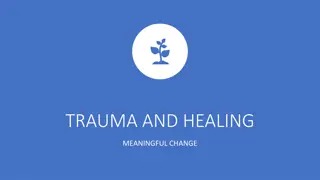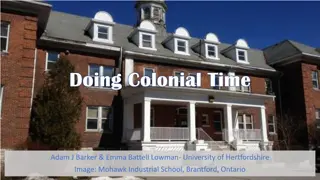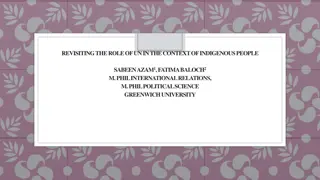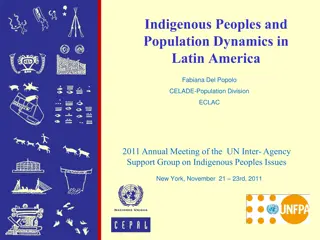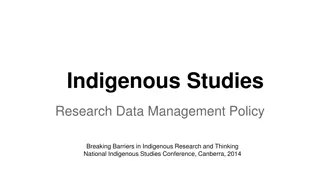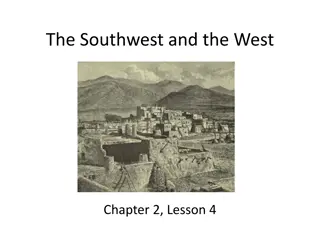Insights into Borderlands and Indigenous Peoples' Perspectives
Explore the concept of Borderlands through a comprehensive week-long program covering topics like sovereign nations, indigenous communities like the O'odham people, and the impact on human rights and nature. Engage in discussions, activities, and reflections to understand the complexities of border issues and cultural interactions.
Download Presentation

Please find below an Image/Link to download the presentation.
The content on the website is provided AS IS for your information and personal use only. It may not be sold, licensed, or shared on other websites without obtaining consent from the author.If you encounter any issues during the download, it is possible that the publisher has removed the file from their server.
You are allowed to download the files provided on this website for personal or commercial use, subject to the condition that they are used lawfully. All files are the property of their respective owners.
The content on the website is provided AS IS for your information and personal use only. It may not be sold, licensed, or shared on other websites without obtaining consent from the author.
E N D
Presentation Transcript
Overview of the Week Day 1 What are Borderlands? Video Borderlands: Bioneers indigenous forum Discussion: Case study O Odham Journal Overview and Entry HW
Homeland Security and Border Patrol Day 2 Journal Presentations (3 Volunteers) Video Part 2: Borderlands: Bioneers indigenous forum Journaling Activity/HW: ID cards Activity
Community Impact Day 3 Video Part 3 Group Discussion Video Journal Exercise Homework
Human Rights: Faith, Religious sites, Inherent Sovereignty Day 4 Entering the Classroom Activity Class Reflection Overview of Homework
Nature and Human Interaction Day 5 Video Part III Religion and spirituality in the middle of the Borderline Class discussion: Does Nature have a say? Final Journal Activity: Time Capsule Hand in Journals
Day 1 A Sovereign Nations Boundaries What are Borderlands? A country is a sovereign nation A border is the line that divides one country or sovereign nation from another Tribal nations are sovereign nations within the United States
Overview of the Four O odom Bands Reservation
Who are the Oodham People O odham is the name of the language that the people of the current Tohono O odham people speak. The people that spoke O odham were the desert dwellers of the Sonoran Desert, settling along the salt, Gila, and Santa Crus Rivers.
Borderlands: Bioneers Indigenous Forumn Borderlands: Bioneers indigenous forum
Class Reflection In 1853, through the Gadsden Purchase or Treaty of La Mesilla, O odham land was divided almost in half, between the United States of America and Mexico. How did it affect families, future generations? Was this right?
Journal Assignment Overview Sample Learning Objectives Journaling assignments can be constructed to assess accomplishment of learning outcomes at any level of the cognitive domain on Bloom s Taxonomy. Here are a few examples of objectives are expected to demonstrated by students through writing in journal posts: Knowledge: Define key terms about borderlands. Understanding: Discuss how you can exhibit knowledge around issues human and nature experience relative to border issues? Application: Illustrate factors that impact how various countries, and sovereign nations create regulations for border control Analysis: Differentiate between both Tohono O'odham people and the US government views of the border wall Evaluation: Critique your experience learning about borders Creation: Complete the Journal to pass down to your peers to learn from
Instructions: 1. 2. 3. 4. 5. Find a thing that will become your written journal Ensure that the journal has the equivalent of 80 pages, and front and back cover Choose a pen, keyboard, or marker to make your journal entries Journals are meant to be opened and read. You will be writing from back to front Open the inside back cover of the journal, write your initials and the date at the bottom right hand corner of the cover (ex dg 01/9/19) With the journal laid out in front of you (cover on your right), write Borderlands on the top left of the left page. Write page 1 on the bottom left corner. Flip the page. Write page 2 on the bottom right corner of the back of page 1. Continue this process. Flip back to page 1. Begin your Journal entry. Should you fill up your space flip to page 2 and continue to write. Write end of entry at the end of each journal entry 10. When starting a new journal entry, start the journal entry on the next corresponding fresh page. Make sure you continue to number the pages. Also make sure you record the date next to the title. 6. 7. 8. 9.
Homework 1: Journal Entry 1 - Borderland Map Assignment Review the Native Land map: https://native-land.ca/ with students. On their own, students will: In a student journal, students will pick up from where they left off writing. Turn to the next clean page. At the top of the page students will label this entry Borderland Map Assignment. Directions: Provide answers to the following questions in your journal. Using the map, https://native-land.ca/ selecting 10 Tribes that share borders. Record the languages that each of these tribes speak? Of the tribes you chose, what treaties have affected those tribes? What issues do you think those tribes may share with the O odham?
Journal Entry Does Land Divide the People? Why? How?
Homeland Security The Department of Homeland Security was established post 9/11 There 5 main objectives are as follows: Counter terrorism and homeland security threats Secure US borders Secure Cyberspace and critical infrastructure Preserve and protect Nation s prosperity and economic security
Homeland Security: 48 Protective Laws waived for construction of the border wall Federal laws waived by DHS for construction of border wall include: 1.National Environmental Policy Act [NEPA] 2.Endangered Species Act 3.Clean Water Act 4.National Historic Preservation Act 5.Migratory Bird Treaty Act 6.Clean Air Act 7.Archeological Resources Protection Act 8.Safe Drinking Water Act 9.Noise Control Act 10.Solid Waste Disposal Act 11.Comprehensive Environmental Response, Compensation, and Liability Act
Waived Contd 12.Archaeological and Historic Preservation Act 13.Antiquities Act 14.Historic Sites, Buildings, and Antiquities Act 15.Wild and Scenic Rivers Act 16.Farmland Protection Policy Act 17.Coastal Zone Management Act 18.Wilderness Act 19.Federal Land Policy and Management Act 20.National Wildlife Refuge System Administration Act 21.Fish and Wildlife Act of 1956 22.Fish and Wildlife Coordination Act 23.Administrative Procedure Act 24.Otay Mountain Wilderness Act of 1999 25.California Desert Protection Act [Sections 102(29) and 103 of Title I]
Waived contd 26.National Park Service Organic Act 27.National Park Service General Authorities Act 28.National Parks and Recreation Act of 1978 [Sections 401(7), 403, and 404] 29.Arizona Desert Wilderness Act [Sections 301(a)-(f)] 30.Rivers and Harbors Act of 1899 31.Eagle Protection Act 32.Native American Graves Protection and Repatriation Act 33.American Indian Religious Freedom Act 34.Religious Freedom Restoration Act
Waived Contd 35.National Forest Management Act of 1976 36.Multiple Use and Sustained Yield Act of 1960 37.Military Lands Withdrawal Act of 1999 38.Sikes Act 39.Arizona-Idaho Conservation Act of 1988 40.Federal Grant and Cooperative Agreement Act of 1977 41.Migratory Bird Conservation Act 42.Paleontological Resources Preservation Act 43.Federal Cave Resources Protection Act of 1988 44.National Trails System Act 45.National Wildlife Refuge System Improvement Act of 1997 46.Reclamation Project Act of 1939 [Section 10] 47.Wild Horse and Burro Act 48.An Act of Oct 30, 2000, Pub. L. 106-398, 1, 114 Stat. 1654
Homework: Create your own Passport Utilize the following reading as a guide to research the requirements of certain forms of ID https://www.dhs.gov/how-do-i/cross-us-borders https://cibtvisas.com/passport-faqs Instructions: Review the websites and any other resource to identify requirements of passports, Identification or License Create your new form of Identification in your Journal. Use markers, crayons, pencil, stickers, pens etc. making sure you add all necessary requirements as found in your research to verify your demographic
Homework contd Create an ID in your journal and discuss: How does one obtain an ID in your chosen country? Who is eligible to receive one? How long it can be used? Where it can be used? How much does it cost? What is your age? What is your marital status? Do you have children? What Ethnicity are you?
Day 3 - Social Impact Broadly spoken, social impact is how individuals, businesses, or organizations actions affect the surrounding community.
Social Impacts of Borders Drug cartels Military Abandoned communities Human rights Living in fear Religious/Spiritual
Video Riding the Death Train
Video Akwesasne Border Issues
Journal Entry 4 Do you believe homeland security is important? From the Akwesasne point of the media attacked the tribe during 9/11. Do you feel this was just? If you were President would you establish the same rules and order as the current President?
Journal Entry 5 Read the following: Akwesasne Nation Passport at the Olympics In student journals respond to the following: Should England have allowed the Iroquois Nationals to Play? Why or why not?
Day 4 THIS CLASSROOM IS NOW THE UNITED STATES OF AMERICA BORDER
Videos Human Rights Video #1: Born Free and Equal Human Rights Video #3: The Right To Life Human Rights Video #4: Freedom From Slavery Human Rights Video #13: Freedom To Move Human Rights Video #14: Right To Asylum
HOMEWORK Homework: Journal Entry 6 Classroom Border Activity Instructions: Write a 500 word essay. Answer the following: Do you feel that today s activity was fair?
Extra Credit Extra Credit (10 pts) Read handout https://safesupportivelearning.ed.gov/sites/default/files/HumanTrafficking inAmericasSchools.pdf Answer the following question in your journal. Title your answer extra credit in large bold letters. How do you identify a standard victim of child trafficking? How can you help them? Students will become aware of a controversial issue Students will be taught how to support their peers and community through awareness
Rights of Nature Rights of Nature is the recognition and honoring that Nature has rights. ... Rather than treating nature as property under the law, rights of nature acknowledges that nature in all its life forms has the right to exist, persist, maintain and regenerate its vital cycles www.celdf.org
Final Activity Students answer the following two questions in your journal (20 minutes) Should we have a US/Mexico border wall? Why? How will the border wall impact future generations?
Hand In your Journals Journals will be saved and passed out next year to the next class that takes this course. Please make sure only your initials are inside the back cover as originally instructed. Thank you
